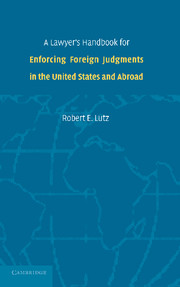Book contents
- Frontmatter
- Contents
- Preface
- Acknowledgments and Dedication
- Introduction
- PART ONE ENFORCING FOREIGN COUNTRY JUDGMENTS IN THE UNITED STATES
- PART TWO ENFORCEMENT OF JUDGMENTS ABROAD
- PART THREE THE FUTURE OF ENFORCING FOREIGN JUDGMENTS
- I Introduction
- II Hague Convention on Exclusive Choice of Court Agreements
- III International Jurisdiction and Judgments Project of the American Law Institute
- IV Revision of the Uniform Foreign-Money Judgment Recognition and Enforcement Act
- V International Trade Flexibility and Enforcing Foreign Judgments
- VI Conclusion
- Bibliography
- Index
V - International Trade Flexibility and Enforcing Foreign Judgments
Published online by Cambridge University Press: 16 November 2009
- Frontmatter
- Contents
- Preface
- Acknowledgments and Dedication
- Introduction
- PART ONE ENFORCING FOREIGN COUNTRY JUDGMENTS IN THE UNITED STATES
- PART TWO ENFORCEMENT OF JUDGMENTS ABROAD
- PART THREE THE FUTURE OF ENFORCING FOREIGN JUDGMENTS
- I Introduction
- II Hague Convention on Exclusive Choice of Court Agreements
- III International Jurisdiction and Judgments Project of the American Law Institute
- IV Revision of the Uniform Foreign-Money Judgment Recognition and Enforcement Act
- V International Trade Flexibility and Enforcing Foreign Judgments
- VI Conclusion
- Bibliography
- Index
Summary
The United States has employed bilateral and multilateral trade agreements to enlarge the scope and liberalize the rules affecting its trading markets. In recent years, it has signed such free trade agreements with Canada and Mexico, Israel, Bahrain, Jordan, Chile, Singapore, Morocco, Australia, and Central America (the countries of Guatemala, El Salvador, Honduras, Nicaragua, Costa Rica, Panama, and the Dominican Republic). The United States is negotiating free trade agreements with New Zealand, Thailand, the United Arab Emirates, with the five member countries of the Southern African Customs Union (SACU) – Botswana, Lesotho, Namibia, South Africa, and Swaziland – Oman, Panama, Peru (trade promotion agreement), and a free trade agreement with the Andean countries of Colombia, Peru, Ecuador, and Bolivia. Discussions have also commenced recently with Korea and Malaysia. These agreements demonstrate U.S. acceptability of other countries' business cultures and suggest an acceptance of a variety of legal cultures for administering justice. Most of these agreements lack provisions for monetary judgment recognition and enforcement, and they do not state a means for resolving disagreements between private commercial parties engaged in transnational transactions.
However, at least one of the more recent bilateral trade agreements in which the United States has entered – with Australia – contains specific language regarding narrow areas of the recognition and enforcement of monetary judgments. The Australian agreement states at Article 14:7 that a monetary judgment should be recognized and enforced, whether it is penal or revenue in nature or based on foreign public law.
- Type
- Chapter
- Information
- Publisher: Cambridge University PressPrint publication year: 2006



